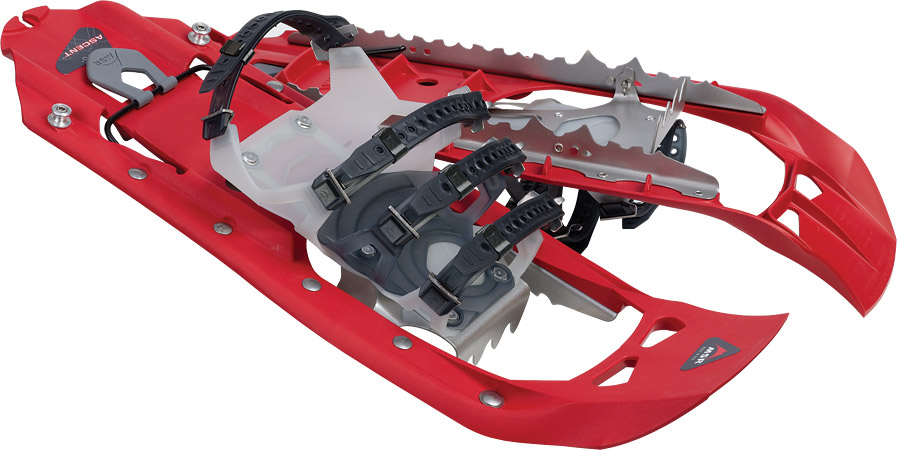Looking for lightweight snowshoes that can handle virtually any situation? The MSR Evo and Evo Ascent models are intriguing snowshoes for those looking for otherworldly traction.
The shoes themselves are 22" in length -- perfect for light snow, traversing ice, hill work, etc., and when the snow gets deep and/or the weight of your backpack goes up you can attach flotation tails which extend the shoe out to 28", enough support for 250 lbs.
However, in my experience, getting those tails attached once the attachment points are iced over can be pretty tough. You'll need a way to melt the ice off or use something like a small wire-bristle brush to scrape them free. The last time I used the tails it took more than five minutes to accomplish what should be a very quick and easy task.
The Evo and Evo Ascent are basically the same shoe with the latter having one extra strap for a total of four in addition to 'Televators' which enable you to raise your boot heel such that climbing steep hills feels like climbing stairs. They are easy to engage and disengage and really work well (a simple twist of the metal will disengage one side and then reverse twist and the other side is unlocked). I only use the 'Televators' for long, continuous ascents because you can find yourself wearing 'high heels' once the terrain flattens out and engaging and disengaging frequently is a pain in the neck. But when the situation calls for these heel-risers (for me about 5% of the time) they are really nice to have.
And speaking of climbing, both the Evo and Evo Ascent versions are real champs when it comes to extraordinary traction. My first use of the Ascent shoes was bushwhacking a steep face of Labrador Mountain near Tully, NY -- at spots greater than 60 degree angles with snow drifting more than two feet. I managed 900 feet of elevation according to my GPS in about 30 minutes. A guy trying to follow in my tracks admitted defeat after floundering around in a traditional pair of Tubbs. While I was standing on top of Lab Mt he was getting back in his car.
And traversing tough sections is made easier with all the extra traction; I traversed this section in Heiberg Memorial Forest in less than a minute by just hopping across all the fallen trees.
Is it worth the extra money to get the Ascent Evos? If you're going to be sticking (and you will stick) to gentle and rolling hills then save yourself the $50 or $60 and get the regular Evos but if you aspire to climb hills then the extra money for the Ascent versions are well worth the extra expense.
The one frequent complaint of the Evo line is their noise. Put simply, Evos are the flip flops of the snowshoe world: once you get a good head of steam built up you'll generate loud clip-clops like a horse and on crusty, icy snow they are very, well, crunchy sounding -- the decks actually amplify the sound of crunchy ice almost like a drumhead. If you're into hunting or wildlife photography (i.e., entering an area as silently as possible) these would probably be the worst shoe possible. However, in fresh, deeper powder they are nice and quiet unless you are really flying along.
If you're going to be crossing streams or traversing through areas featuring a lot of groundwater seepage up you will have to de-ice the traction rails and crampon frequently which means poles are not optional: you'll be knocking the these shoes to get the ice off -- otherwise they will double their weight in seconds of crossing a stream.
The other concerns I have are (1) after a few weeks the metal binding parts began to rust on all my Evo snowshoes. The performance is not diminished but you'd expect better; (2) after 50 miles of use an intermittent squeak developed in the left shoe and, after 75 miles the squeak is now acute. Have some white lithium grease on hand to solve this problem.
All in all, however, the Evo and Evo Ascent are good choices for people looking to trek across varied terrain with maximum traction. I would buy them again and would recommend them to others.
Pros: lightweight, sturdy, secure, best traction possible
Cons: noisy, oxidizing metal, clumsy tail attachment under icy conditions

